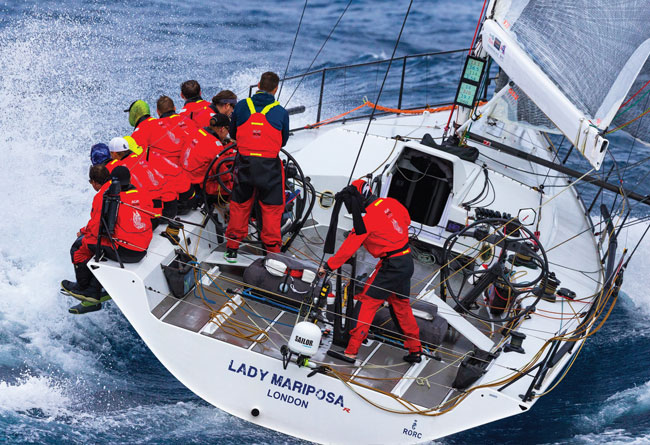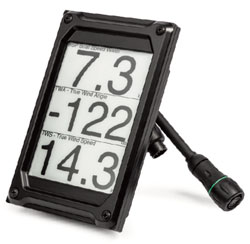

The rest of the smarts behind Sailmon’s easy-to-readeven- in-bright-sunlight displays are very cool too...
Sailing is a numbers game but the displays we rely on to read those crucial numbers often let us down. Sailmon solves this problem, bringing the latest data display and processing technologies to all sorts of sailors, whether they are on foiling dinghies, sportboats, cruiser-racers, Grand Prix racers or superyachts.
Sailmon’s innovative product lines look great and are based on the latest processors, displays and networking methods. And with its adaptable platforms and infrastructure, Sailmon is able to continuously innovate in developing new products and solutions. Its advanced technology, which originated aboard superyachts and Grand Prix racing yachts, is now accessible to all sailors with the Element Ink display, the newest member in the Sailmon family.
Bright sunlight and viewing angle blockage with polarised sunglasses can often limit the visibility of standard LCD or LED-based displays. Element Ink introduces for the first time EPD technology, which has no blackout angles from polarised sunglasses. The characters on Element Ink displays can also be seen across the widest possible range of conditions, from bright sunlight to complete darkness, making this an attractive solution for offshore yachts, whether racing or cruising.
Element Ink’s EPD technology has progressed over the last few years from a humble beginning in e-book readers to extensive use by a number of America’s Cup teams from BAR to Artemis for the 36th America’s Cup. Sailmon has taken this technology further, making it stronger and better for a broader audience.
Despite weighing in at just 500g, Element Ink is a robust display that can withstand all weather conditions and yet has the highest resolution of all Sailmon Element displays (1072 x 1448 pixels) – and also the lowest power consumption due to the use of EPD technology. This makes Element Ink especially attractive to smaller boats with limited battery power.
Below: this prototype Element Ink display is crisp as well as crystal clear to read

The next positive feature of Element Ink is actually common to all Element displays: adaptability. Like the Element 7 and Element 10, the Element Ink has an adaptable screen so characters can be automatically adjusted in size to accommodate more information than just numbers (such as graphing trends) and it can be configured in both portrait and landscape orientations. Displays may be configured with free format values, digits, graphs and data layouts via Sailmon’s NavDesk app, which allows the user to show as much data as desired. This is a clear example of how Sailmon works hard to integrate the latest technologies into the sailing experience.
Because its size fits existing display dimensions, Element Ink is a perfect candidate to upgrade an older system that has less functional display. Adding the processor allows compatibility to existing sensors and protocols. This is one of the system’s best features: its adaptability makes upgrades much easier.
With Sailmon’s E4 processor as part of the upgrade, even more functionality is possible. The Ethernetbased network can speak all languages to and from third party sensors and displays – for example NMEA, B&G, Nexus or Raymarine protocols. Calibration data is made available, along with numerous choices of screen options and everything can be automatically uploaded to the Cloud for later analysis, review and sharing.
E4 can even support and bridge several different legacy networks simultaneously and upgrade their capabilities, allowing for the reuse of old system displays from many manufacturers. Units such as Garmin GNX, B&G Fastnet and Sailmon Element X or VII can all be connected to the system.
The E4 Silver processor is more than powerful enough for most boats’ data requirements, while the E4 Black is designed for Grand Prix and Superyacht users with custom sensor inputs, external channels over UDP and complex calibration and processing functions.
Regardless of processor type, Sailmon systems allow displays to be daisy-chained, giving more flexibility in placement around the boat where they are needed most, whether on the rig for a large raceboat, or in the cockpit for a sportsboat. Their durability and flexibility in display functions are a signature feature that has driven the popularity of Sailmon on boats of all sizes and types.
Sailmon devices represent the next step in marine technology that is both accessible and indispensable for every sailor, both on and off the water. And the innovation continues: three more new Sailmon products are set to launch in 2019.
Click here for more information on Sailmon »
We invite you to read on and find out for yourself why Seahorse is the most highly-rated source in the world for anyone who is serious about their racing.
To read on simply SIGN up NOW
Take advantage of our very best subscription offer or order a single copy of this issue of Seahorse.
Online at:
www.seahorse.co.uk/shop and use the code TECH20
Or for iPad simply download the Seahorse App at the iTunes store


